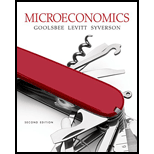
(a)
Equilibrium wage.
(a)
Explanation of Solution
Given information:
Demand function of labor:
Supply function of labor:
Calculation:
Intersecting point of demand and supply curve of labor is the equilibrium point. The corresponding wage in the equilibrium point is the equilibrium wage rate. The calculation of equilibrium wage is shown below:
Equilibrium wage is $8.
Substitute the wage rate in to the demand equation (Equation (1)) to calculate the
Equilibrium quantity of labor is 80 (80,000) units.
Equilibrium wage and quantity: The intersecting point of demand and supply curve of labor is the equilibrium point. The corresponding wage and quantity in the equilibrium point is the equilibrium wage rate and equilibrium quantity of labor.
(b)
New equilibrium wage.
(b)
Explanation of Solution
Given information:
New equilibrium wage rate: $9.
Calculation:
Substitute the new wage rate in to the demand equation (Equation (1)) to calculate the new equilibrium quantity of labor.
New equilibrium quantity of labor is 60 (60,000) units.
Substitute the new wage rate in to the supply equation (Equation (2)) to calculate the quantity of labor supplied.
Quantity of labor supplied is 90 (90,000) units.
The
The excess supply of labor is 30,000.
Equilibrium wage and quantity: The intersecting point of demand and supply curve of labor is the equilibrium point. The corresponding wage and quantity in the equilibrium point is the equilibrium wage rate and equilibrium quantity of labor.
(c)
(c)
Explanation of Solution
At wage $9, the quantity demand for labor is 60,000 units (this is calculated in sub-part (b)). Even though, at wage $9 more number of labors (more than 60,000) are ready to provide their
Acceptable labor wage at quantity 60,000 (60 units) is $6.
Deadweight loss is calculated as follows:
Deadweight loss is $30,000.
Deadweight loss: Deadweight loss is the loss of economic surplus because of the market economy not being in the competitive equilibrium.
(d)
Change in
(d)
Explanation of Solution
To find out the
Substitute the value of quantity demand as zero in Equation (1).
The demand chock price (maximum willing wage) is $12.
Change in consumer surplus is calculated as follows:
Change (decrease) in consumer surplus is $70,000.
To find out the producer surplus, the chock price of supply curve has to be calculated. The calculation of chock price is shown below.
Substitute the value of quantity supply as zero in Equation (2).
The supply chock price (minimum acceptable wage) is $0.
Change in producer surplus is calculated as follows:
Change (increase) in producer surplus is $40,000.
Producer surplus: Producer surplus is the difference between the lowest willing price accepted by the producer and the actual price received by the producer.
Consumer surplus: Consumer surplus is the difference between the highest willing price of a consumer and the actual price that the consumer pays.
(e)
Change in producer surplus.
(e)
Explanation of Solution
Substitute the new wage rate in to the demand equation (Equation (1)) to calculate the new equilibrium quantity of labor.
New equilibrium quantity of labor is 20 (20,000) units.
At wage $11, the quantity demand for labor is 20,000 units. Even though, at wage $11 more number of labors (more than 20,000) are ready to provide their service, market quantity of 20,000 labor only. Thus the new acceptable labor wage at quantity 20,000 (20 units) is calculated as follows.
Acceptable labor wage at quantity 20,000 (20 units) is $2.
Deadweight loss is calculated as follows:
Deadweight loss is $270,000.
To find out the consumer surplus, the chock price of demand curve has to be calculated. The calculation of chock price is shown below:
Substitute the value of quantity demand as zero in Equation (1).
The demand chock price (maximum willing wage) is $12.
Change in consumer surplus is calculated as follows:
Change (decrease) in consumer surplus is $150,000.
To find out the producer surplus, the chock price of supply curve has to be calculated. The calculation of chock price is shown below:
Substitute the value of quantity supply as zero in Equation (2).
The supply chock price (minimum acceptable wage) is $0.
Change in producer surplus is calculated as follows:
Change (decrease) in producer surplus is $120,000.
Producer surplus: Producer surplus is the difference between the lowest willing price accepted by the producer and the actual price received by the producer.
Consumer surplus: Consumer surplus is the difference between the highest willing price of a consumer and the actual price that the consumer pays.
Want to see more full solutions like this?
Chapter 3 Solutions
Microeconomics (Instructor's)

 Principles of Economics (12th Edition)EconomicsISBN:9780134078779Author:Karl E. Case, Ray C. Fair, Sharon E. OsterPublisher:PEARSON
Principles of Economics (12th Edition)EconomicsISBN:9780134078779Author:Karl E. Case, Ray C. Fair, Sharon E. OsterPublisher:PEARSON Engineering Economy (17th Edition)EconomicsISBN:9780134870069Author:William G. Sullivan, Elin M. Wicks, C. Patrick KoellingPublisher:PEARSON
Engineering Economy (17th Edition)EconomicsISBN:9780134870069Author:William G. Sullivan, Elin M. Wicks, C. Patrick KoellingPublisher:PEARSON Principles of Economics (MindTap Course List)EconomicsISBN:9781305585126Author:N. Gregory MankiwPublisher:Cengage Learning
Principles of Economics (MindTap Course List)EconomicsISBN:9781305585126Author:N. Gregory MankiwPublisher:Cengage Learning Managerial Economics: A Problem Solving ApproachEconomicsISBN:9781337106665Author:Luke M. Froeb, Brian T. McCann, Michael R. Ward, Mike ShorPublisher:Cengage Learning
Managerial Economics: A Problem Solving ApproachEconomicsISBN:9781337106665Author:Luke M. Froeb, Brian T. McCann, Michael R. Ward, Mike ShorPublisher:Cengage Learning Managerial Economics & Business Strategy (Mcgraw-...EconomicsISBN:9781259290619Author:Michael Baye, Jeff PrincePublisher:McGraw-Hill Education
Managerial Economics & Business Strategy (Mcgraw-...EconomicsISBN:9781259290619Author:Michael Baye, Jeff PrincePublisher:McGraw-Hill Education





